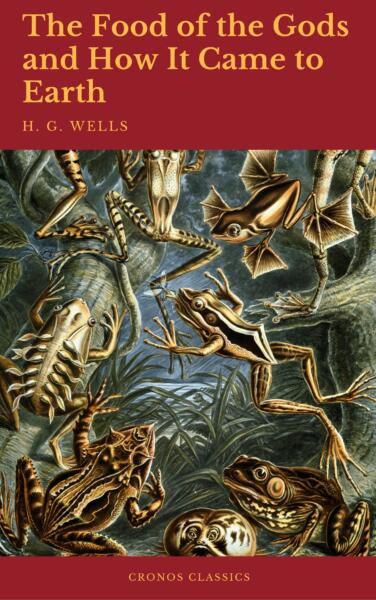
In H. G. Wells’s The Food of the Gods, the chickens, which are the first things fed the food, grow grotesquely large and begin eating cats. Disturbance in size, thick bodied and too close, the food carries with it a disturbed temperament. Rage and perverse eating.
Oobleck is a non-Newtonian fluid. We make it in a metal mixing bowl, and it resembles milk, but it is milk that can be punched. When I squeeze it, it moves from a liquid to a solid. Then, I release my grip, and it returns to a liquid.
The body of an infant, stretched and filled: a fully bodied presence. The body becomes the corporealization of time, and time becomes brittle, an elongated neck, full of the potential for its own displacement or exchange. Look at the Madonna’s neck, her long fingers, her eyes. Each snapped. Or, as Sjoerd van Tuinen writes in “Mannerism, Baroque, and Modernism: Deleuze and the Essence of Art,”
“The great achievement of mannerist deformation is that it renders time or life visible in painting—not just a time that flows and can be narrated as such, but also one that is always out of step, enduring and coexisting with other times…” (174).
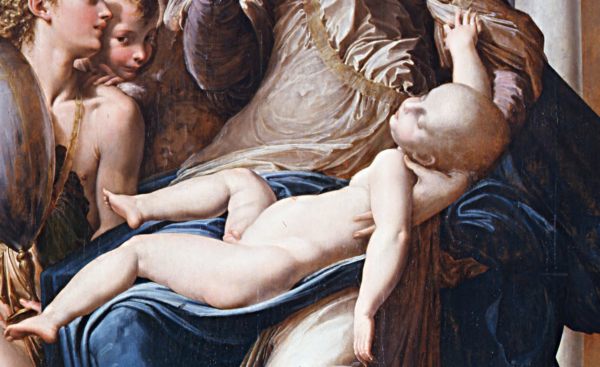
Detail from Madonna with the Long Neck (1535-1540) by Parmigianino
This coexistence is the theater of the massive deformed present. The inquiry is one of constant return: time and time again, or “rendering time visible.”
Chronos and his children: giants and their mouths, giants and their cannibalism. Giants in Wells’s book are made that way through their eating. The food itself is a problem, per Wells, in no small part because of “dissemination”: “our whole story is one of dissemination” (125). These “branching” exposures to the growth hormone are further described as transformative leakages, an insurgency of the large. The insurgency cannot be controlled; it moves “slowly, by indirect sources and against resistance.” The food is corruptive, invasive, and it works due to a “cardinal fact of time.” In other words, “it is the leakages make history.”

The Food of the Gods (1976) Directed by Bert I. Gordon
The food first escapes from an experimental farm set up for the studying of the food. The scientists behind the discovery are ultimately inept, incapable of understanding the scale of change that the food will bring. “They do not,” Wells tells us, “seem to realize the things they are doing” (12). The changes to the environment are rapid: stork-sized chicks, tiger-sized rats, huge wasps, and hypertrophic vegetation. The changes at first seem anomalous and reversible. The farm, wasps, and vegetation are burned; the giant rats are shot in their tunnels. But the new scale cannot be circumscribed. So, watchtowers spring up to warn of swarms of deadly rats. Children don’t go out. Ponds and springs fill with horrors. People alter their lives to the ever-branching crisis of scale.
The food is thin and subtle: a sinuous and fluid substance. A long finger extending outward into other fingers. Obviously a rhizome. But it’s also massive, a titan and aligned with “bigness” and “time” and “history.” The food is mannerist, perhaps baroque; it is surreal. And it inflates the bodies of those who consume it; they are moved into a new order.
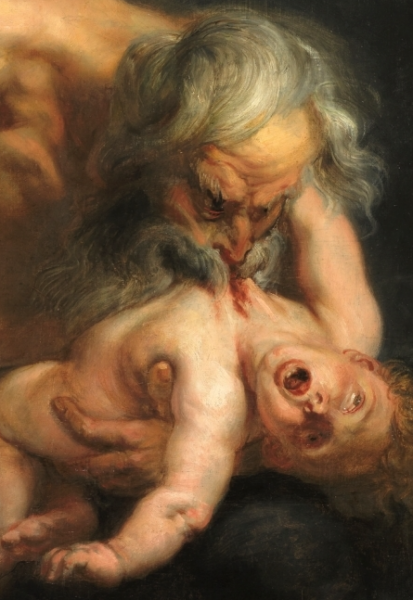
Peter Paul Rubens’ Saturn Devouring His Son (1636)
The parents in the novel want giant children; they want their brood to become perversely large, a logic of dominance and a strange return to Chronos and his children. Where Chronos devours to maintain his power, the scientists and engineers feed their children to ensure their children’s greatness and the parents’ own devouring. The parents recline, in expectation, offering the world to their children’s desire. While Chronos represents time, he is also a representation of social revolution: the toppling of one regime and its replacement. So, too, is Wells’s story, which explores a revolution in scale, a massive overturning of the human order. The novel fixes its discussion of this revolution in the reactionary politics that emerge in change, the credulity of “pure” scientific approaches to human problems, environmental catastrophe, and geopolitical crisis.
The giants themselves are full of desire. Fetishists: “what are you for?” They ask us over and over. The giants wonder at the “pygmies,” and the giants want something, but it’s unfixed. The giants are inflated with need. They are time’s incessant eating. They expose that scale predicates “universal” values ostensibly unfixed in time. Always just-so stories, but what will we do with the super-inflated vegetation, the giant rats?
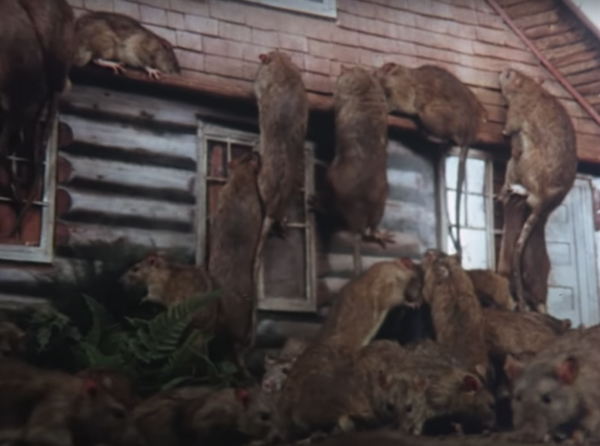
The Food of the Gods (1976) Directed by Bert I. Gordon
The giant, David Williams tells us in Deformed Discourse “is appropriately a war against containment.” Like the food in Wells’s story, the giant resists boundary, flows beyond it, is an admixture:
“the giants of classical myth possess incomparable strength and ferocity; they are always bearded and covered all over by hair, except for their legs, which are often composed of serpents.”
While perhaps not immediately evident, the giant is
“a figure whose deformation signifies the breaking of the confines of genus as container of being and the transgression of the separating limits of animal, human, and divine” (114).
The giant is a chimera, a blend of human and non-human. It violates its category, creates horror in its subversion of the human, while also
“uphold[ing] the notion of the autonomous body, especially the human body, by actually violating it” (Wamberg 260).
The body is invaded, Wamberg explains in “Trafficking the Body,” by “less complex matter, and thus needing the memory of the uninvaded body as a necessary counter figure.” The giant is a suspension.
When not placed under stress, oobleck resembles a fluid. When it is placed under stress, oobleck becomes a solid. The corn starch suspended in water flows, one around the next, free moving. The stress placed on the corn starch causes the particles to transform the substance into a solid. The substance is a counterintuitive comingling of difference. Oobleck branches, leaks, solidifies, resists. When placed on a speaker, oobleck dances and snakes. It resembles, in my mind, the expressive formations on Solaris. The planet’s oobleckian surface is a monstrous communicative field. Madison McCartha, who describes it as “plaster-like,” notes that the speaking surface works “both as a landscape and as a text,” and they wonder “what does its lyric ‘I’ want to say?” In other words, the planet, per McCartha, is the pastoral shepherd, “a collapse between the text and the speaker, whereby the poem speaks as the poem itself.” This collapse carries a strong resemblance to the confusion over “work” (ergon) and “bywork” (parergon) described by Wamberg. The ornament (“the partridge on top of the column”) becomes the subject. The landscape becomes the subject that speaks.
The virgin’s fingers are extravagant: gorgeous, erotic, almost gastronomic in their length.
Mannerism and the giant are not just spectacle. They are disintegrated and over-integrated: the gerund, endless bolts of flesh, the volume. Or, as Wamberg writes, “the nonhuman ocean totally floods the dominant pictorial paradigm” (247).
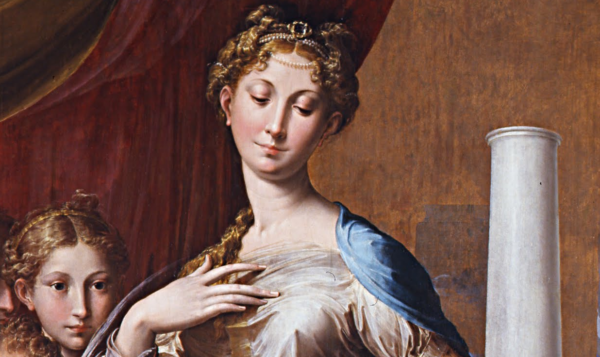
Detail from Madonna with the Long Neck (1535-1540) by Parmigianino
Parmigianino’s painting Madonna with the Long Neck is thoroughly dream-like and heterogenous, an up-swelling from a deep eely ocean. It is, in contrast, also totally physical: the bodies so dense, so complete. They’re thick. A mass of giants, and a ghostly saint, ostensibly at a distance, but plainly a Thumbelino. As van Tuinen writes of Mannerism generally,
“In breaking up the continuum of successive perceptions and replacing it with the transspatial simultaneity of different stages of movement, the typical figura serpentinata fixes the fact of movement, its spiritual presence, in an instantaneous becoming . . .” (174).
In the painting’s center is the snake-like Madonna holding the giant baby, bald and enormous. Its right-hand clutches at her robes; its left dangles in space. Her own right hand extends into a riot of fingers. Her left clutches the unsupportable child under the arm. Beside her is a group of cherubs, six in all. They are glutted together, eyes in all directions. The Madonna’s enormous foot points outward toward the spectator. And to her left is a doll-like St. Jerome. Because the painting was never finished, he’s partly transparent. His own severed ghost foot is planted behind him, as is an array of towering columns that, due to the unclear perspective, resemble a devil’s pitchfork. At their pedestals, there appear to be many, while at the capital, just one.
The giant rising out of the mist or crouched under the hill—longing, deformation—tells us that the world is not ours. We were never coherent, never complete. Look behind you, observe your spectral foot.
Philip Sorenson is the author of Of Embodies (Rescue Press, 2012) and Solar Trauma (Rescue Press, 2018). A shorter handmade work, New Recordings, was released by Another New Calligraphy in 2018, but it’s now out of print. He co-edits The Journal Petra with Olivia Cronk.